- Walk up to the ball, set the club down in position, place your feet, and flex your knees slightly
- Look up to the target, waggle the club head once or twice, and return your eyes back down to the ball
- Start the swing by turning your shoulders away from the target
There are a number of fundamental elements that you need to get right in order to build a quality golf swing which will hold up round after round. Although points such as balance and grip get a lot of attention – and rightfully so – it is important not to overlook the stance in this conversation. Your stance should be considered one of the key ingredients in the recipe of your swing, as standing over the ball properly is going to make the rest of your job much easier. Most amateur golfers fail to spend much time at all working on their stance, and the results speak for themselves. Take at least a few moments during each practice session to pay attention to your stance and you should quickly see improvement in the quality of your play.
This article is going to highlight ten of the best golf stance tips ever created. These tips are going to be relatively simple in nature, yet they can have a powerful impact on your swing and on your game as a whole. Take a moment to think carefully about each one before moving on to the next. And, of course, once you have finished reading the article, find a time to actually get out and practice these points. Nothing is going to happen in your golf game without practice, so applying what you learn here is going to be the biggest key to real progress.
All of the tips below have been written from the perspective of a right handed golfer. If you happen to play left handed, please take a moment to reverse the directions as necessary.

If you hope to make a great golf swing, you are going to have to start by using your legs to build a great stance. This is a point that is never overlooked by professional golfers, yet many amateurs fail to understand just how important the lower body is to the golf swing. At address, you need to have your knees flexed and the large muscles in your legs engaged and ready to go. If you were to stand over the ball with your knees straight, you would not have a ‘platform’ for the rest of your swing. Think of your legs in the stance as the foundation of a house – without the foundation, the house is sure to fall to the ground.
It should be noted that you don’t have to go into a deep knee bend or anything like that in order to engage your legs. Even just a minor amount of knee flex can be enough to engage the important muscles in your lower body before starting the swing. The best way to find a good lower body position in the stance is to feel like you are starting to sit down in a chair. This action will force your backside out behind you slightly, which is exactly what you want to do in order to build the solid platform that you need. In the end, your knees should be flexed, your backside should be sticking out behind you, and your muscles should feel engaged and ready to perform.
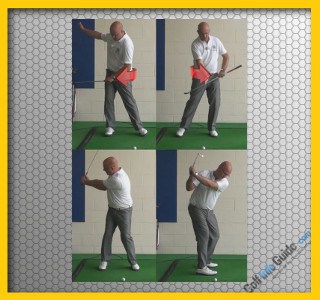
#2 – Open the Right Foot for a Better Turn
One of the amazing things about the stance in golf is how much influence it has over the rest of the swing. That is the case with this tip, where you can actually improve on your backswing turn simply by opening up your right foot slightly at address. If you currently stand with both of your feet square to the target line in your stance, try turning your right foot open by just a few degrees to add length to your backswing. With your right foot open, your right knee will be able to ‘give’ a little bit more going back – resulting in a better turn. When everything else remains equal, a better turn is going to lead to added speed and greater distance.
While this is a great way to improve on your rotation, you do need to be careful to not lose track of your balance along the way. When your right knee gives a little bit going back, you may find yourself pulled onto your right side – ruining your balance, and making it difficult to strike the ball cleanly. So, as you swing back, focus on making a great turn while still keeping your weight directly in the middle of your stance. The backswing should be a rotational action, so any sliding away from the target needs to be eliminated as quickly as possible.
There is no set amount for how much you should open your foot to the target line at address, so experiment with various degrees until you settle on a comfortable position. This is not a tip that you necessarily have to use, either – if you already make a great turn back, you may decide to keep your foot square to the line in order to promote better balance. Try this little adjustment out for yourself on the range and make a determination on whether or not this will be a helpful element to include in your stance.
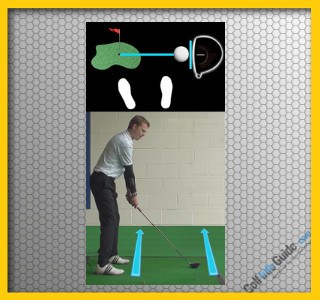
It is nearly impossible to build a quality stance without first picking out a specific target for your upcoming shot. Why? Because the target you pick serves as a point of reference that you are going to use to set your feet, align your shoulders, etc. Golf is a target-based game, and yet many players fail to pick a specific target before getting into the process of hitting a shot. By focusing on having a target for all of your shots – both in practice and on the course – you will find that your stance is able to perform at a higher level.
As you are picking your targets, be sure to get as specific as possible in order to give your mind a detailed direction for the shot. It is easy to say that you are going to aim for the ‘middle of the fairway’, but what does that mean exactly? Instead, pick out a specific tree in the distance, or a discolored spot in the fairway, and focus your swing on that point. You will be better able to build a great stance when you have a specific target selected, and your swing should be more confident as well.
This same concept applies when hitting approach shots. Your target is going to be the hole itself in some instances, but that won’t always be the case. When you do need to aim away from the hole, pick out a specific spot and keep that spot in your focus until you make the swing. Professional golfers are great at using targets to orient their stances, and you should be trying to follow that lead.

#4 – Make Yourself Comfortable While Putting
The stance that you use on the golf course is not only important while making full swings – it is also an important component of your short game as well. When putting, you want to shift your focus away from technical issues and instead make sure you are as comfortable as possible over the ball. There isn’t much happening during a good putting stroke – you just have to stand still while the putter rocks back and through – so the technical elements of your stance are of lesser importance.
Most golfers are going to feel comfortable in their putting stance when they keep their feet relatively close together while having just a bit of flex in the knees. You want to stand a bit taller than you do in your full swing because you need to provide the putter with plenty of room to swing freely through impact. Try starting out with a stance that has your feet just slightly inside of your shoulders. From there, you can adjust a bit wider or narrower as necessary until you find the right balance. Once you find a stance that feels comfortable to you while putting, do your best to keep it consistent from day to day.

#5 – Gradual Width from Driver to Wedge
It would be a mistake to try using the same stance width for all of the clubs in your bag. Since your clubs aren’t all the same length – they get progressively shorter from the driver down to the wedges – it makes sense to vary the width of your stance in order to match the club in your hands. As you might expect, you should have your stance at its widest when you are swinging the driver, and it should be as narrow as it is going to get when hitting a wedge. For all the clubs in between, you are gradually going to bring your feet closer together as the clubs get shorter. For instance, your three wood stance should be just barely narrower than your driver stance, and your nine iron stance should be just slightly wider than the stance you use with your wedges.
You don’t want to have to think about the specifics of the width of your stance while out on the course, which is why practice becomes such an important part of the equation. During practice, you can move your way through your bag in order, hitting one or two shots with each club. As you move down your bag from driver to wedge, you can gradually bring your feet closer and closer together. If you practice this way consistently, you will soon have a natural feel for the width of your stance without having to think about it consciously. You want to be able to take your stance on the course without even giving it a second thought, and that is exactly what will happen after an extended period of practice.
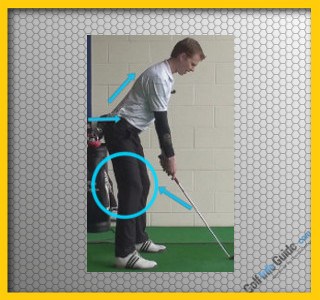
The order with which you take your stance is actually going to have an impact on how accurately you are able to aim while standing over the ball. As you walk up to the ball to take your stance, it is important that you place your club head down behind the ball first before positioning your feet. When you work in this order, you will be able to get a good look at the target while placing the club head on the ground, ensuring you are aimed properly. If you were to position your feet first and then put the club down at the end, it would be significantly harder to align yourself correctly with the target.
Once you have placed your club head down on the ground behind the ball, you can then use the club head as a point of reference while setting your feet. Assuming you are trying to hit a relatively straight shot (as opposed to a big curve), you are going to want to place your feet such that they are parallel with the face of the club head. Also, it is at this point that you are going to set your ball position as a result of where you put your feet. To make sure this process works smoothly out on the course, practice taking your stance in this specific order on the driving range. Between each shot, step back from your hitting area, pick out a target, walk back up and get set. It will take a bit longer to work through a bucket of balls when you use this method, but your practice will be far more meaningful and beneficial.

Golf would be quite a bit easier – and not nearly as much fun – if it were always played on flat ground. Dealing with uneven lies is a part of the game that you will need to conquer if you are going to reach your potential, and understanding how to stand when on a slope is an important skill. If you do find your ball on a slope of some kind, you almost always want to add width to your stance in order to improve stability. You won’t be able to make as big of a turn in most cases after adding width, but power shouldn’t be your first concern when on a slope. Instead, you want to make sure you can stay balanced so you will be able to strike the ball as cleanly as possible.
In addition to adjusting the width of your stance, you should also alter your ball position slightly when the ground is uneven below your feet. If playing from a downhill lie, move the ball back in your stance to make it easier to catch the ball before the turf. The same is actually true when playing from an uphill lie, as moving the ball back in your stance will limit the amount of weight transfer you need to achieve. By playing the ball back in your stance from an uneven lie, you will get a lower flight but you should be able to at least make solid contact on a consistent basis.
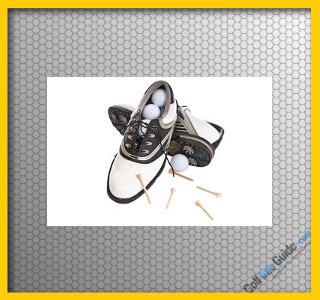
You might not think much about your golf shoes once you are on the course, but they play a crucial role in your ability to hit good shots. You need good traction in order to make aggressive, confident golf swings, and that traction is only going to be provided by a quality pair of shoes. If you try to play in tennis shoes, or in old golf shoes that have lost their grip, you are sure to notice a drop in performance. While you don’t need to spend a lot of money on top-of-the-line shoes in order to play well, you do need to at least have a pair of shoes that are going to allow your feet to stay in place throughout your swing.
When you pick out a pair of shoes, it is important to keep in mind where you usually play your golf. Are you frequently playing in the desert with dry conditions and hot weather, or do you play somewhere cool and soggy? Those two different climates are going to require dramatically different shoes, so you need to shop smart to wind up with a pair that is right for your needs. Those playing in wet environments will need waterproof shoes that offer plenty of grip from heel to toe. On the other hand, you won’t often slip when playing on a desert course, so you can focus more on comfort and style than sheer performance.
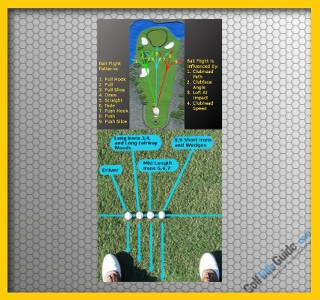
#9 – Small Tweaks Mean Big Ball Flight Changes
If you are hoping to alter your ball flight in order to produce a specific shot, you may be able to achieve the desired affect simply be changing your stance in a minor fashion. For example, imagine that you usually play a slight fade with all of your clubs, but you would like to hit a draw in order to get around a dogleg that is in front of you. To produce a draw rather than a fade, you can close your stance by moving your right foot back away from the target line. This movement doesn’t need to be dramatic to achieve results – just moving your foot back by a couple of inches should lead to a new shot shape. Of course, the more you change your stance, the more difference you should expect to see in your ball flight.
As you would probably guess, it would be a mistake to experiment with these kinds of tweaks out on the course without first trying them out in practice. It takes some time and practice to learn how to shape your ball on command, so spend plenty of time working on this point at the driving range. Pick a target in the distance and try to hit that target first with a draw, then with a fade. Go back and forth, changing your ball flight by changing your stance at address. With practice, you can improve on your ability to shape shots, and you will suddenly have a whole new world of ball flights at your disposal.

One of the worst things you can do before hitting a golf shot is to get stuck in your stance. If you stand over the ball too long after taking your stance, you may find yourself stuck – meaning you are having a difficult time getting your swing started. This is a common problem, and it has even affected some of the top players in the world from time to time. To steer clear of this issue, you need to keep things moving within your pre-shot routine. Rather than standing over the ball for several seconds while you stare at the target, just take a quick look and then put the club in motion. Without time to think, you will let your natural instincts take over – which is almost always the best way to play the game.
When executed correctly, the sequence of events prior to starting your swing will look something like this –
When written out, this process looks simple – and it is. If you can just avoid overcomplicating the process as you get ready to hit your shots, there should be no issue with getting stuck in your stance prior to the swing.
There is little doubt that the stance is one of the most important fundamentals in the game of golf. Sure, it probably isn’t the most exciting thing to work on when you take a trip to the driving range, but it can pay big dividends if you are willing to focus in on this fundamental piece of the golf puzzle. With a great stance on your side, another big hurdle will be cleared along the path toward a better game.






